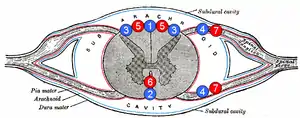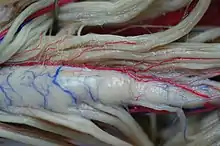Segmental medullary artery
Segmental medullary arteries are arteries of varying size in the thoracolumbar region that arise from segmental arteries of this region (posterior intercostal arteries or lumbar arteries) and pass through intervertebral foramina to supply the spinal cord.[1] They may join the anterior spinal artery.[2]
| Segmental medullary artery | |
|---|---|
 1: Posterior spinal vein 2: Anterior spinal vein 3: Posterolateral spinal vein 4: Radicular (or segmental medullary) vein 5: Posterior spinal arteries 6: Anterior spinal artery 7: Radicular artery | |
| Details | |
| Branches | Anterior spinal artery |
| Identifiers | |
| Latin | Arteria medullaris segmentalis |
| TA98 | A12.2.11.016 A12.2.08.007 A12.2.12.007 |
| TA2 | 4535 |
| FMA | 86039 |
| Anatomical terminology | |
The largest anterior segmental medullary artery is known as the artery of Adamkiewicz.
Anatomy
Development
During embryological development, about 75% of the segmental medullary arteries regress, forming the thinner (anterior and posterior) radicular arteries (which supply the two roots and sensory ganglion of each spinal nerve); the remaining segmental medullary arteries persist to contribute arterial supply to the spinal cord, as well as giving rise to the aforementioned radicular arteries.[1]
Gallery
.jpg.webp)
References
- Waschke, Jens; Böckers, Tobias M.; Paulsen, Friedrich; Arnold, Wolfgang; Bechmann, Ingo, eds. (2018). Sobotta Anatomy Textbook: English Edition with Latin Nomenclature (1st ed.). München: Elsevier. p. 623. ISBN 978-0-7020-6760-0.
- Huntoon MA (2005). "Anatomy of the cervical intervertebral foramina: vulnerable arteries and ischemic neurologic injuries after transforaminal epidural injections". Pain. 117 (1–2): 104–11. doi:10.1016/j.pain.2005.05.030. PMID 16055268.
